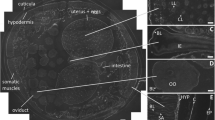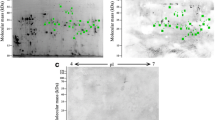Abstract
This work investigated the location on the parasite ofTrichinella antigens recognized by the mouse immune system and the question as to which of them bear the epitope phosphorylcholine (PC). Wheatley's trichrome stain (initially developed for faecal smears) proved to be excellent for visualization ofTrichinella structures, enabling four types of stichocyte to be distinguished. By applying this stain on infected muscle sections after immunocytochemistry using (a) anti-PC BH8 monoclonal antibodies, (b) serum from mice that had been infected twice in the presence of 0.05% thiabendazole (to prevent reproduction by adult females) and then bled on day 7 post-reinfection, (c) serum from infected mice that were bled on day 14 postinfection, or (d) serum from infected mice that were bled on day 42 postinfection, we found (1) that PC is an abundant structural epitope on the hypodermis/muscle, genital primordium and intestinal tract but is absent from the cuticle and stichosome; (2) that the principle secretory cells of adult worms are delta- and beta-stichocytes, whereas those of migrating and encysted L1 larvae are alpha-stichocytes; and (3) thatTrichinella antigens recognized in the encysted phase of the parasite's life cycle are present in parasitized myofibres in the sarcoplasmic matrix and in the nucleoplasm of hypertrophic nuclei. The significance of these findings is discussed.
Similar content being viewed by others
Abbreviations
- BCF1 :
-
(BALB/c x CBA/J)F1
- IMDM:
-
Iscove's modified Dulbecco's medium
- PC:
-
phosphorylcholine
- PBS:
-
phosphate-buffered saline
- TBS:
-
TRIS-buffered saline
- TBS-Tween:
-
TBS containing 0.2% (v/v) Tween-20
References
Bailenger J (1982) Coprologie parasitaire et fonctionnelle. Imprimerie Péchade, Bordeaux, pp 47–56
Bruce RG (1970) Structure of the esophagus of the infective juvenile and adultTrichinella spiralis. J Parasitol 56:540–549
Campbell WC, Cuckler AC (1964) Effect of thiabendazole upon the enteral and parenteral phases of trichinosis in mice. J Parasitol 50:481–488
Despommier D (1985) Antigens ofTrichinella spiralis. In: Kim CV (ed) Trichinellosis. Proceedings of the Sixth International Conference of Trichinellosis. Suny Press, New York, pp 8–16
Despommier DD (1990)Trichinella spiralis: the worm that would be virus. Parasitol Today 6:193–196
Despommier DD, Müller M (1976) The stichosome and its secretion granules in the mature muscle larva ofTrichinella spiralis. J Parasitol 62:775–785
Faro J, Seoane R, Puentes E, Ubeira FM, Regueiro BJ (1985) Immunoresponses toNeisseria meningitidis epitopes: primary versus secondary antiphosphorylcholine responses. Infect Immun 48:428–432
Gualzata M, Weiss N, Heusser CHH (1986)Dipetalonema viteae: phosphorylcholine and non-phosphorylcholine antigenic determinants in infective larvae and adult worms. Exp Parasitol 61:95–102
Gualzata MD, Rudin W, Weis N, Heuser CHH (1988) The crossreactive immune response between infective larvae and adult worms ofAcanthocheilonema (Dipetalonema) viteae is dominated phosphorylcholine. Parasite Immunol 10:481–492
Gutman GA, Mitchell GF (1977)Ascaris suum: location of phosphorylcholine in lung larvae. Exp Parasitol 43:161–168
Jasmer DP (1990)Trichinella spiralis: altered expression of muscle proteins in trichinosis. Exp Parasitol 70:452–465
Leiro J, Santamarina MT, Sernández L, Sanmartín ML, Ubeira FM (1988) Immunomodulation byTrichinella spiralis: primary versus secondary response to phosphorylcholine-containing antigens. Med Microbiol Immunol 177:161–167
Leiro J, Baltar P, Santamarina MT, Sanmartín ML, Ubeira FM (1989) Cinética de la respuesta inmunitaria humoral frente a epitopos deTrichinella cuantificada por la técnica dot-ELISA [A] VI Congreso Nacional y I Congreso Ibérico de Parasitología, Cáceres, p 116
Maizels RM, Selkirk ME (1988) Immunobiology of nematode antigens. In: Englund PT, Sher A (eds) The biology of parasitism. Alan R. Liss, New York, pp 285–308
Ooi HK, Kamiya M (1986) Antibodies to nurse cell and various stages ofTrichinella spiralis in patient sera. Jpn J Parasitol 35:109–113
Parkhouse RME (1989)Trichinella spiralis: a model parasite. In: Tanner CE (ed) Trichinellosis. Proceedings of the Seventh International Conference on Trichinellosis. Consejo Superior de Investigaciones Científicas Press, Madrid, pp 13–17
Sanmartín ML, Santamarina MT, Ubeira FM (1986) Effect of clofibrate and hydrocortisone on intestinal trichinellosis in mice. Vet Parasitol 21:55–60
Santamarina MT, Leiro J, Garrido MJ, Sanmartín Durán ML, Ubeira FM (1988) The effect of the adult worms and newborn larvae ofTrichinella spiralis on the production of antiparasite IgE antibodies. Parasitol Res 74:581–585
Silberstein DS (1983) Antigens. In: Campbell WC (ed)Trichinella and trichinosis. Plenum Press, New York, pp 309–334
Silberstein DS, Despommier DD (1984) Antigens fromTrichinella spiralis that induce a protective response in the mouse. J Immunol 132:898–904
Takahashi Y, Yoshikawa Y, Furuki J, Yamada S, Araki T (1987) Morphological study ofTrichinella spiralis: an overall picture of a muscle larva as revealed by longitudinal sectioning. Jpn J Parasitol 36:361–366
Takahashi Y, Uno T, Mizuno N, Suzuki H, Yagi J, Araki T (1988a) Immunohistochemical localization of antigenic substances inTrichinella spiralis muscle larvae. Jpn J Parasitol 37:63–68
Takahashi Y, Yoshikawa Y, Kim H, Aisaka A, Yamada S, Araki T (1988b) The morphological findings ofTrichinella spiralis as revealed by PAS and AZAN stainings Jpn J Parasitol 37:242–247
Takahashi Y, Uno T, Mizuno N, Yamada S, Araki T (1989) Ultrastructural localization of antigenic substances inTrichinella spiralis. Parasitol Res 75:316–324
Tijssen P (1987) Enzyme immunohistochemistry (EIH) in light and electron microscopy. In: Burdon RH, Knippenberg PH van (eds) Laboratory techniques in biochemistry and molecular biology. Practice and theory of enzyme immunoassays. Elsevier, Amsterdam, pp 449–499
Ubeira FM, Leiro J, Santamarina MT, Sanmartín ML (1987a) Modulation of the anti-phosphorylcholine immune response duringTrichinella spiralis infections in mice. Parasitology 95:583–592
Ubeira FM, Leiro J, Santamarina MT, Villa TG, Sanmartín ML (1987b) Immune response toTrichinella epitopes: the antiphosphorylcholine plaque-forming cell response during the biological cycle. Parasitology 94:543–553
Wakelin D, Denham DA (1983) The immune response. In: Campbell WC (ed)Trichinella and trichinosis. Plenum Press, New York, pp 265–308
Wemhoff GA, Quintans J (1987) Alterations of idiotypic profiles: the cellular basis of T15 dominance in BALB/c mice. J Mol Cell Immunol 3:307–318
Wheatley WB (1951) A rapid staining procedure for intestinal amoeba and flagellates. Am J Clin Pathol 21:990–991
Yoshikawa Y, Takahashi Y, Uno T, Furuki J, Shimazu K, Araki T (1987) Morphological studies onTrichinella spiralis (1) [A]. Jpn J Parasitol 36:16
Author information
Authors and Affiliations
Rights and permissions
About this article
Cite this article
Sanmartín, M.L., Iglesias, R., Santamarina, M.T. et al. Anatomical location of phosphorylcholine and other antigens on encystedTrichinella using immunohistochemistry followed by Wheatley's trichrome stain. Parasitol Res 77, 301–306 (1991). https://doi.org/10.1007/BF00930905
Accepted:
Issue Date:
DOI: https://doi.org/10.1007/BF00930905




